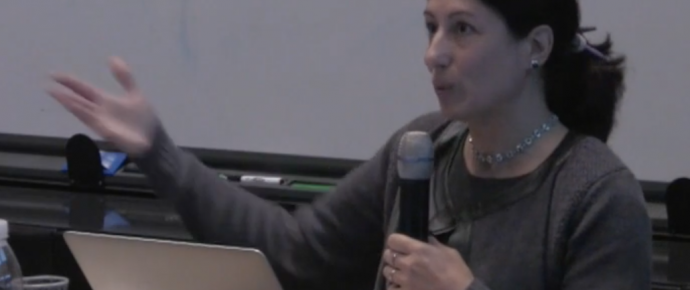WATCH MIMI SHELLER’S KEYNOTE, MOBILIZING HYBRID CITIES
Professor Mimi Sheller of mCenter Drexel opened the 10th Cosmobilities conference in Copenhagen on Networked Urban Mobilities. In her lecture, ‘Mobilizing Hybrid Cities’, she adds theoretical perspectives on digital art and locative media to the themes of mobilities studies and urban studies. In the talk Sheller asks how social sciences can take a more active role in shaping urban mobilities and how mobile media and geolocational data produces new relations of people to space, to community, to interaction and to communication. We also had a small chat with Mimi about her experience at the conference, which you can read below the video.
On the last day of the Networked Urban Mobilities Conference in 2014, we sat down with Mimi Sheller and asked a few questions about her experience of attending the Cosmobilities event in Copenhagen.
Sune & Oskar: What will you take with you from this conference?
I’ve been really excited about the younger scholars that are coming up and thinking about the mobilities perspectives and how to incorporate them into new research projects, and for me, in one of the last sessions we had a great conversation about the relation between micro-level research and macro-level problems, systems and structures. I think we are getting some interesting new ways of bridging the micro and the macro through mobilities research.
S & O: What has been the best or most surprising experience at the conference?
I just think the atmosphere has been really nice; in fact, we have had papers talking about “affective atmosphere”, and I think one of the great achievements of the cosmobilities network is creating a conducive and friendly atmosphere for people to exchange their work. For me that’s the best thing about it.
S & O: Where do you see the cosmobilities network and these conferences going from here? /What is the future of this network?
Well, next year it is our joint conference in Italy, which is a great future to look forward to. But I see efforts to really establish the field as not just a research network but sort of more than that. We have a growing set of publications, and hopefully new PhD’s and new positions in universities that will come out of this work that has gone on in this 10-year period.
S & O: How do you think the mobilities paradigm is developing, what is the future of the mobilities paradigm?
I think it is increasingly being taken note of by governments, by engineers, by designers, by transport planners and so, I think we are having a greater and greater impact on these kinds of realms of actual decision-makers, that are actually shaping the world, and I hope our research can help make better worlds in the future.

